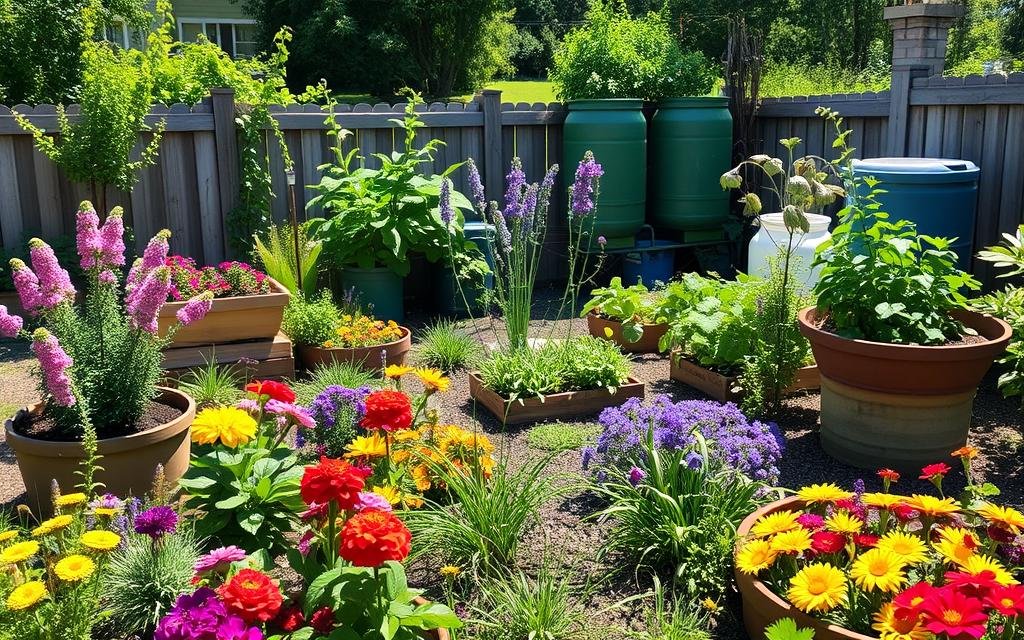Creating a green oasis doesn’t have to harm the environment. Traditional gardening uses a lot of water and energy. But, gardening has changed, bringing in sustainability. This change shows that eco-friendly gardening helps our planet and makes our gardens peaceful and successful12.
Eco-friendly gardening uses nature’s power, freeing gardeners from needing lots of resources and constant upkeep. It makes gardening better for the environment2.
Using compost, drip irrigation, and native plants makes gardening eco-friendly. This approach fits with nature’s cycles1. It’s a way of life that values nature and aims to leave a smaller mark on Earth. By recycling and reducing waste, we can cut down on landfill waste1. Choosing sustainable materials and designs helps our gardens and the planet2.
Key Takeaways
- Eco-friendly gardening cuts down on water and energy use, making life greener12.
- Healthy soil from eco-friendly methods supports plant health12.
- Practices like composting and mulching improve soil and plant health1.
- Mulching and drought-resistant plants save water1.
- Using native plants and materials reduces environmental harm and supports nature12.
- A chemical-free pest control protects the ecosystem2.
- Eco-friendly gardening fits into a sustainable lifestyle, teaching us to care for the environment2.
Introducing Eco-Friendly Gardening
I’ve been exploring eco-friendly gardening and it’s amazing. It’s not just about making gardens look nice. It’s about taking care of the earth and respecting nature’s power.
The Essence of Earth-Friendly Gardening
Eco-friendly gardening is all about being sustainable and caring for the earth. It uses green gardening methods to make gardens fit well with nature. This way, we use fewer chemicals and focus on organic ways to keep soil and plants healthy.
Understanding the Environmental and Personal Benefits
Eco-friendly gardening helps the earth and us. It brings more life to gardens and makes them healthier. It also makes our gardens a peaceful place for our minds and bodies.
Making the Shift to a Garden That Cares for the Earth
Switching to an eco-friendly garden means using methods that help the earth. Using rainwater and composting cuts down on waste. This kind of gardening also helps solve big problems like water waste and soil damage.
Eco-friendly gardening is more than just pretty gardens. It’s about living in harmony with nature. By choosing sustainable gardening, we join a global effort to protect our planet. It’s a rewarding way to make a difference.
| Benefit | Technique | Impact |
|---|---|---|
| Water Conservation | Composting and Mulching | Reduces water usage and retains soil moisture |
| Carbon Sequestration | Planting Trees | Helps absorb atmospheric carbon, mitigating climate change |
| Biodiversity Enhancement | Cultivating Native Plants | Attracts beneficial insects and promotes ecological balance |
| Soil Health Improvement | Building Compost Piles | Enhances soil fertility and structure |
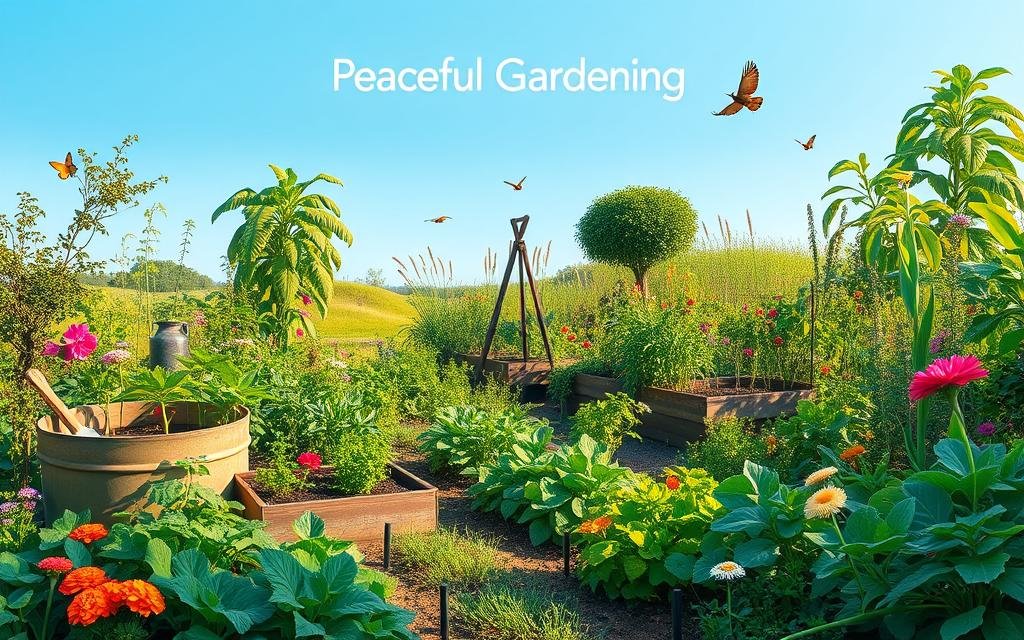
Using eco-friendly gardening methods like composting and planting native plants helps our gardens and the planet. These actions make our gardens better for us and for nature. They show how our health and the planet’s health are connected3.
What is Eco-Friendly Gardening?
Eco-friendly gardening is more than a trend. It’s a way to help the natural world. It uses organic methods and aims for a low impact on the environment. This approach helps keep our planet healthy.
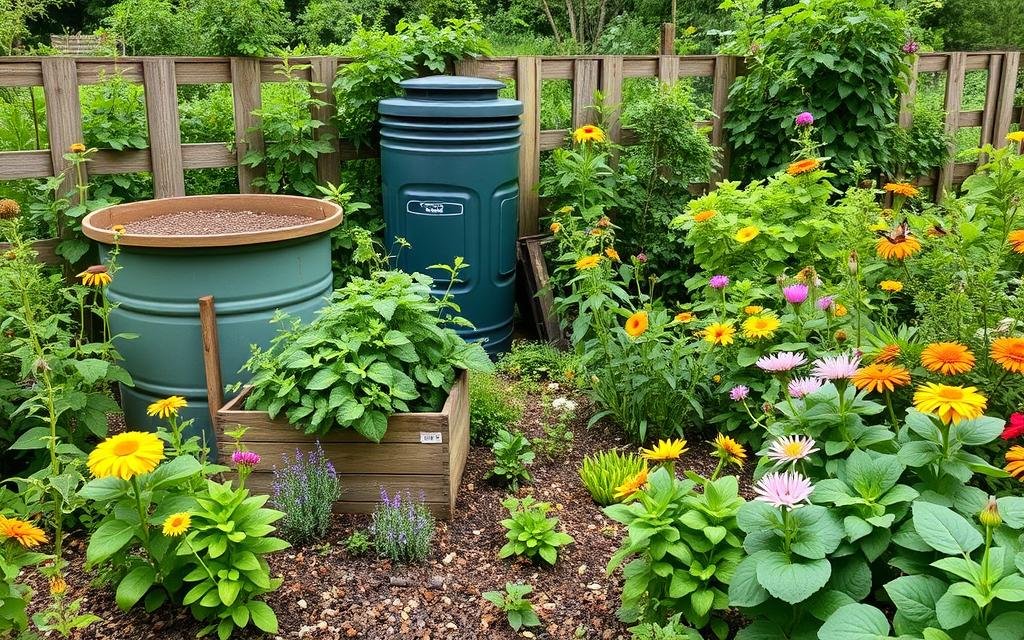
Using eco-friendly gardening tips helps our environment and the ecosystem. For example, growing native shade trees helps local wildlife and cools our homes. This can lower our energy bills4.
Adding plants like leafy greens and tomatoes means we can eat well with less effort. This reduces our need for industrial farming and its harm to the environment5.
Organic gardening has many benefits, not just for our gardens. Composting at home saves energy and turns waste into plant food. This makes our soil better and helps the planet6.
Using rainwater for our gardens helps protect wetlands. It’s a way to support the environment and save water6.
Practices like mulching and choosing the right plants save water and keep soil healthy. This helps fight climate change and supports nature45.
Chemical-free gardening keeps us and our gardens safe. It creates a home for helpful insects and microorganisms. This leads to a garden that takes care of itself.
By choosing eco-friendly gardening, we help fight climate change and protect nature. We can make a big difference, one garden at a time.
The Role of Soil Health in Eco-Conscious Gardening
I love gardening and focus on eco-friendly ways. Soil health is key for a sustainable and productive garden. I use natural soil amendments, composting, and careful soil management to create a strong garden ecosystem.
Creating a Living Soil Ecosystem
I start making a living soil ecosystem by adding organic matter through composting. I put compost in each planting hole to boost soil health and structure7. This helps the underground world of tiny creatures break down organic stuff. They help with nutrient cycling and keeping nutrients in the soil7.
Composting Techniques for Soil Enrichment
I don’t just add compost to the soil. I use different composting methods to turn waste into nutrients. This helps reduce waste and makes my soil full of nutrients for healthy plants7. I till and mulch regularly to keep the soil right, saving water and preventing soil loss8.
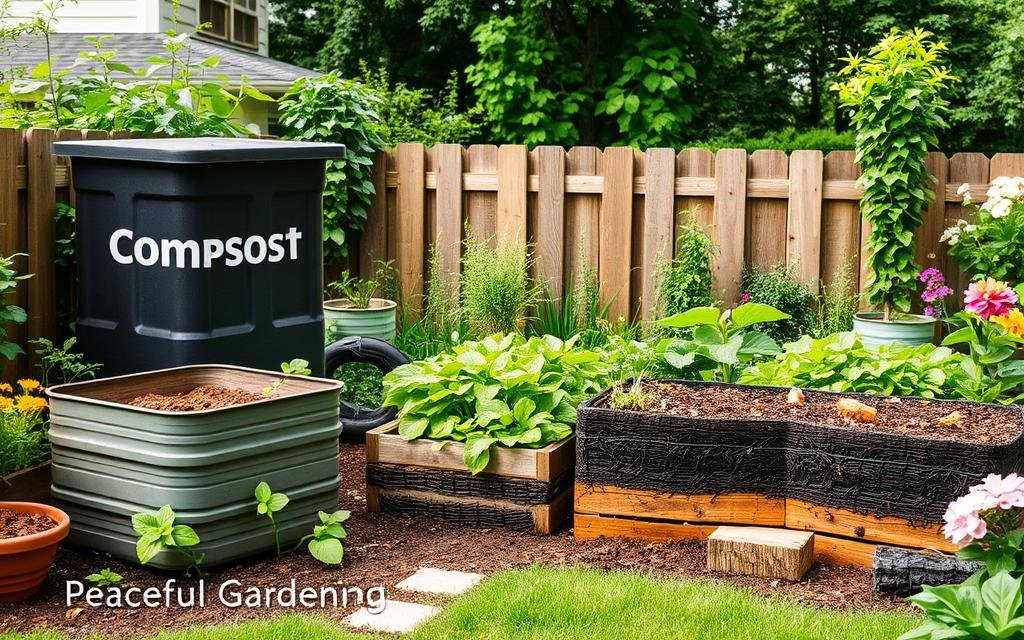
Adding natural soil amendments and managing water well makes the soil better. This helps plants grow strong and healthy. It also helps with biodiversity and fights against environmental harm, which is good for my eco-friendly garden8.
Conserving Water: Lifeblood of Your Garden
As a gardener, knowing how to save water is key. It’s vital in today’s world where we’re all trying to be more eco-friendly. Using systems that save water helps my garden do well, even when it’s tough.
Water-Saving Strategies and Rainwater Harvesting
Using rainwater systems has cut my water bills by 30-50%9. I put rain barrels and catchment systems to good use. Watering my garden in the early morning helps too. It cuts down on water lost to evaporation10.
Practices like using ollas and mulching are great for saving water. Ollas can save up to 70% of water10. Mulching keeps soil moist, which means using less water10.
Drought-Tolerant Plant Selection for Water Conservation
Choosing plants that don’t need much water has changed my garden. These plants need less water, which helps me save more. Using xeriscaping has cut my water use by 50-75%9.
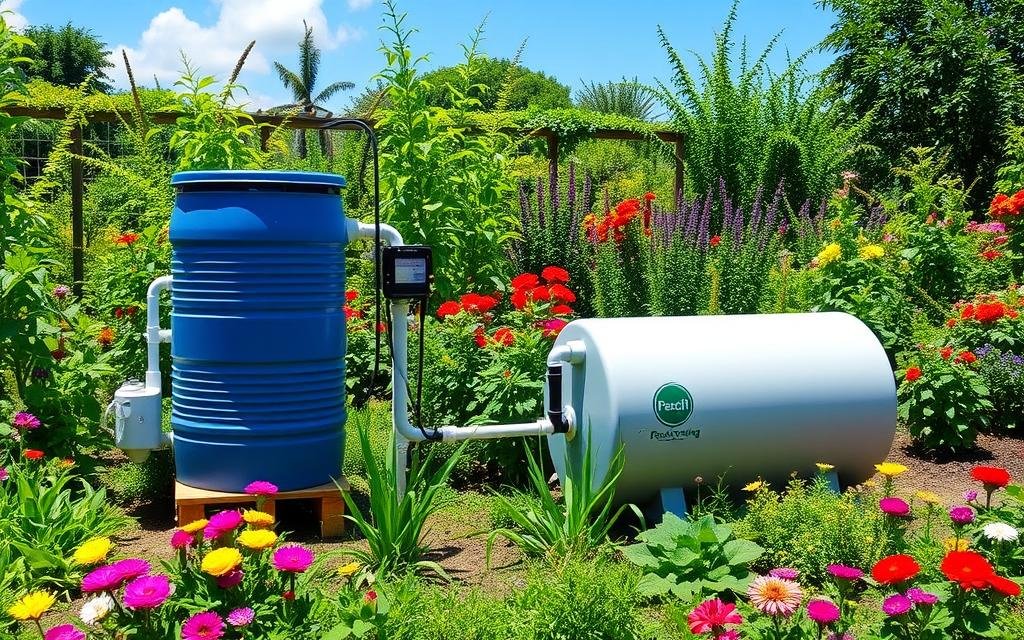
Changing how I garden has helped save water and made my garden healthier. Using smart rainwater systems and picking the right plants makes a big difference. Every step we take helps make the future greener.
Biodiversity: Cultivating Life in the Garden
I’ve made my garden more eco-friendly by focusing on biodiversity. By growing many types of plants, we make our gardens beautiful and help nature. Adding native plants makes our gardens safe havens for wildlife.
Attracting Pollinators and Beneficial Wildlife
To draw pollinators, I pick the right plants for my garden. I have native flowers, shrubs, and trees that feed bees, butterflies, and birds all year. Plants like lavender for bees and milkweed for butterflies help local pollinators, which are key for a healthy ecosystem11.
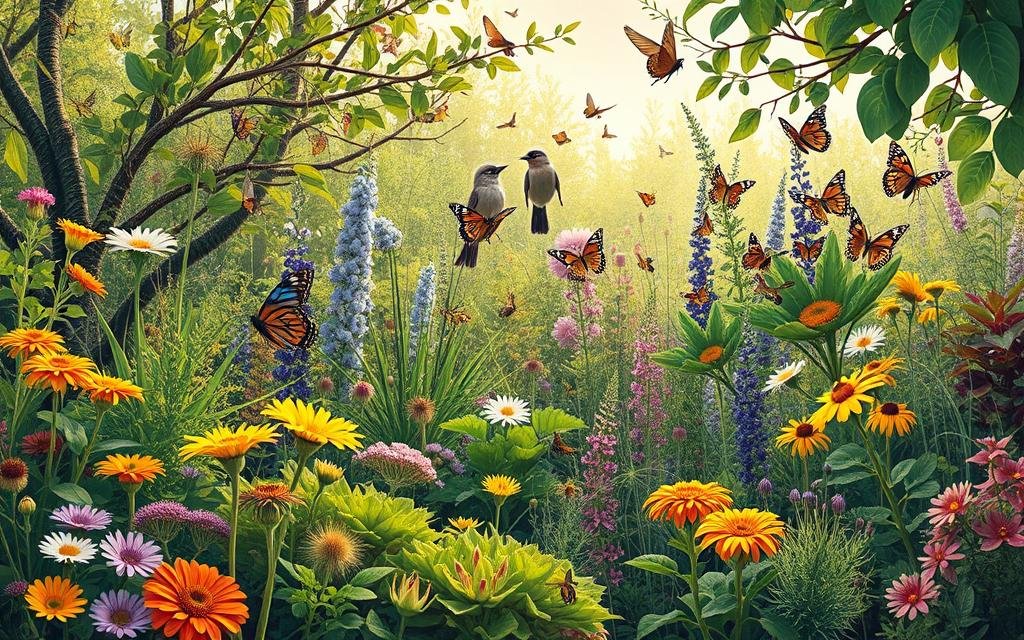
The Importance of Plant Diversity and Native Species
Keeping my garden diverse is a challenge I’ve taken on. I have a herb garden and an ornamental area with many plants. Each part of the garden helps make a safe place for many species11. Plants native to my area are the heart of this diversity. They need less water and fewer chemicals, making my garden better for the planet.
Using cover crops and rotating crops in my vegetable garden helps the soil and bugs. These methods boost biodiversity and keep pests away naturally. They make my garden stronger against changes1112.
My garden is now a place of beauty and peace. It also helps protect our local wildlife and the environment. Every plant and gardening trick I use is a step towards a greener future. It shows my love for the earth and how it supports us.
Natural Pest Control: A Chemical-Free Approach
Using natural pest control in my garden has made it safe for beneficial insects. It also stops the use of harsh chemicals. Organic pest management is a way to keep pests away without harming the environment. For instance, Integrated Pest Management (IPM) is a top choice for keeping pests away in an eco-friendly way13.
I often use natural repellents to keep pests away. Peppermint oil, vinegar, citrus peels, and essential oils work well because of their strong smells and tastes13. Adding ladybugs to my garden helps control aphids. This is part of organic pest management that keeps my garden healthy13.
Creating barriers and traps helps keep pests out of my home. This keeps my family and pets safe. It follows the rules of organic pest management13. Using nematodes and microbial insecticides like Bacillus thuringiensis (Bt) targets pests without harming beneficial insects1314.
I also use neem oil, insecticidal soaps, and garlic sprays to fight pests. These are safe for plants and beneficial insects. They keep the soil healthy and help pests stay in balance15. By doing sustainable gardening, I help my garden stay healthy and pest-free15.
I think natural pest control and organic methods make my garden better. They keep it safe for insects, my family, and pets. It’s a chemical-free space for everyone.
Responsible Plant Selection and Care
I love gardening and want to help the planet. I focus on picking plants that are good for the earth. I use methods that stop weeds naturally and feed plants well. This makes my garden better for everyone.
Growing Native and Drought-Resistant Plants
Choosing plants that are native and can handle drought is good for nature. These plants help local animals and need less water. This saves water and is great for dry areas16.
Using organic stuff to feed my plants makes the soil better. It gives plants what they need and helps bugs that are good for the garden16. This makes my garden work better and keeps water clean16.
Moving Beyond Invasive Species for Garden Health
It’s important to pick plants that don’t harm the garden. Mulching keeps the soil moist and stops weeds. It also keeps the soil cool for my plants16.
Collecting rainwater is good for the planet and my garden. It helps us use less city water16. Picking plants that can handle dry times means I use less water. This makes my garden pretty and saves resources16.
When I garden, I follow these rules. Every plant I pick helps the earth. This way, my garden is a safe place for me and animals. By gardening the right way, we can all make a difference.
Sustainable Gardening Practices and Their Global Impact
More people are turning to sustainable agriculture because it’s needed to fight environmental issues. By using permaculture and helping gardens absorb carbon, we can help nature and our planet. Permaculture teaches us to work with nature, making systems that fix and improve themselves17.
Permaculture is more than saving nature; it changes how we grow food and care for the earth. It means making choices that boost nature’s diversity, soil health, and the strength of ecosystems. This way of farming greatly cuts down on carbon emissions and helps keep the environment balanced17.
Carbon Sequestration and Climate Change Mitigation
In sustainable gardening, every action we take can help lower global carbon levels. Using composting helps the soil and stops waste from making methane18. Also, planting densely or like a forest can pull carbon from the air, helping our planet17. These actions turn permaculture ideas into real ways to fight climate change.
Regenerative and Permaculture Gardening Fundamentals
At the heart of regenerative gardening is giving back more to the earth than we take. By planning gardens with many different plants, we use less water and don’t need synthetic fertilizers as much1817. Adding permanent and cover crops also helps the soil, saves water, and builds up nutrients naturally. These methods are key in permaculture, making gardens that support wildlife and produce food without needing much help.
The Magic of Mulching: Benefits Beyond Soil Health
I love sustainable living and find that mulching is a big help. It makes the soil better and helps with gardening. Mulching keeps the soil moist, which is great for places with little rain or water rules19.
Mulches stop weeds from growing too. They block sunlight and release stuff that weeds don’t like19. This means you spend less time pulling weeds and more time enjoying your garden. Mulches like bark or compost also give nutrients to the soil as they break down19.
When you put down mulch, use about 2-3 inches for best results19. Don’t pile it too high near plants to avoid rot or pest issues19.
Using both organic and inorganic mulches works well for different spots. Organic ones need to be replaced every year but help the soil a lot as they break down20. Inorganic mulches like gravel or rubber last a long time and are easy to take care of20.
Mulching is key to making gardens better and greener. It’s not just about stopping weeds or saving water. It’s about making a big, positive change for the planet. With mulching, my garden is healthy and I feel good about helping the earth.
| Benefit | Organic Mulch | Inorganic Mulch |
|---|---|---|
| Soil Health | Improves with nutrient release | Minimal impact |
| Longevity | 1 year before replacement | Lasts several years |
| Maintenance | Yearly replenishment | Low maintenance |
| Weed Control | Natural deterrence by blocking sunlight | Effective over long periods |
| Water Conservation | Excellent moisture retention | Varies by type but generally good |
By using mulching right, my garden looks great and shows the good of organic farming2019. I hope sharing my story will encourage others to use mulching in their gardens. It’s a great way to make your garden healthier and more eco-friendly.
Integrating Wildlife-Friendly Features
I love gardening and want to help nature. I focus on making a home for wildlife in my garden. Adding bird feeders and native plants makes my garden a place of beauty and life.
Wildlife-friendly gardening is all about making a home for birds, insects, and animals. I plant many types of plants to attract bees, butterflies, and other creatures. This way, my garden is a place of food and shelter for them21.
Designing Habitats for Birds, Insects, and Animals
To make a great garden for wildlife, we need food, water, shelter, and places to breed. I use insect hotels and woodpiles to help local animals. Each thing I add is chosen to help nature thrive21.
Creating Eco-Systems with Gardens as Sanctuaries
I focus on making my garden safe for plants and animals. I don’t use harmful chemicals. This helps plants grow strong and keeps animals healthy21. Using native plants is good for the garden and local animals22.
| Feature | Benefits |
|---|---|
| Insect hotels | Shelter and breeding sites for beneficial insects |
| Native plants | Support local wildlife, reduce maintenance and water use22 |
| Woodpiles | Attract and support a range of creatures from frogs to slow worms |
| Rainwater collection systems | Minimize water usage while providing vital hydration points for wildlife22 |
| Bird feeders and baths | Provide essential resources for birds, enhancing biodiversity21 |
Working with nature, my garden has become a lively place for many animals. It’s a safe spot for even the smallest creatures. This helps keep our planet healthy21.
Green Living: Eco-Friendly Gardening as a Lifestyle Choice
Choosing to garden in an eco-friendly way means more than just picking plants and digging. It shows a deep commitment to our planet. I love eco-conscious lawn care because it’s both a duty and a joy. It lets us care for nature in a thoughtful way.
Low-Impact Gardening Tools and Techniques
My move to green living changed when I found low-impact gardening tools. Switching to manual or electric tools cuts down on pollution. Using solar lights and biodegradable pots helps our planet too.
Techniques like mulching and drip irrigation save water and help soil health. This makes our gardens a key part of sustainable landscaping2324.
Educating on Environmental Stewardship Through Gardening
Gardening is a great way to teach about taking care of the environment. I’ve seen how sharing knowledge about native plants and biodiversity helps. By planting flowers for bees and leaving some areas wild, we can help more wildlife and reduce our impact on nature23.
Showing how composting reduces waste and makes soil better also highlights the perks of living sustainably2524.
Advancing Your Garden’s Ecosystem Services
As I explore ways to improve my garden, I focus on supporting the soil microbiome. This means using practices that help natural garden ecosystems and keep ecological balance. I use data and successful examples to guide my eco-friendly gardening.
Understanding and Supporting the Soil Microbiome
The soil microbiome is key to a healthy garden. It helps plants grow strong, absorb nutrients better, and fight diseases. No-till gardening is great for it. It keeps the soil’s structure and homes for microbes, which helps with soil health and storing carbon26.
Enhancing Garden Ecosystems for Human and Environmental Health
Gardens are good for people and the planet. They add beauty and help keep nature in balance. By adding trees and shrubs, I help with carbon capture and support wildlife, like bees26. Diverse plants also cut down on carbon emissions and energy use by providing shade and blocking wind26.
The USDA’s People’s Garden Initiative is inspiring. It focuses on community gardens that teach about conservation. This project has grown, helping communities support local food systems and protect nature27.
Using biochar in my garden has changed things a lot. It helps the soil hold water and nutrients better, which is good for the soil life. This method also helps with carbon capture26.
| Practice | Benefits | Impact on Soil Microbiome |
|---|---|---|
| No-till Gardening | Reduces soil disturbance | Preserves microbial habitats26 |
| Using Biochar | Improves soil water retention | Enhances nutrient efficiency26 |
| Planting Diverse Species | Attracts beneficial insects | Increases biodiversity26 |
| Community Gardening | Supports local food systems | Encourages public engagement in sustainability27 |
Every step I take in my garden follows the idea that a well-kept garden helps the soil and the planet. By understanding how these elements work together, I make my garden a better place for everyone.
Eco-Friendly Materials and Sustainable Landscaping
I love making my garden both pretty and green. I use upcycled materials and eco-friendly ways to do it. This helps reduce my environmental impact28. I pick things like recycled pavers to save natural resources and cut down on energy use28. This also helps keep our landfills cleaner28.
Natural Alternatives to Traditional Garden Structures
Using permeable pavers is great. They help save water, keep the ground cool, and make soil healthier28. I get advice from pros like McNeil Engineering to pick materials that are good for the planet28. Things like fly ash concrete or recycled aggregate concrete are strong and look good28.
Using plants that don’t need much water cuts down on garden work and saves water29. This makes my garden better for the environment and saves energy, up to 25%29.
Upcycling and Recycling in Garden Design
I also focus on the top of my garden with green roofs. These roofs keep my home warm and save on energy bills, helping city wildlife29. LED lights are another green choice, using less energy and lasting longer than old bulbs29.
My garden is full of plants that help bees and looks great with things like reclaimed bricks and stones29. It’s a place that’s alive, supports many kinds of life, and fights pests without harsh chemicals29.

My name is Michelle Warren, and I’m the founder of Peaceful Gardening. As a 10-year breast cancer survivor, I’ve discovered the profound therapeutic power of gardening. This journey has not only helped me recover but has also become my passion and a source of ongoing peace and joy.
Peaceful Gardening was born from my desire to share the healing benefits of gardening with others. Whether you’re facing health challenges, dealing with stress, or simply looking to connect more deeply with nature, this space is for you.
Over the past decade, I’ve cultivated not just plants, but a deep understanding of how gardening can positively impact mental health. I’ve worked with local community gardens, led workshops on mindful gardening practices, and collaborated with mental health professionals to develop gardening-based stress reduction programs.
Peaceful Gardening was born from my desire to share the healing benefits of gardening with others. Whether you’re facing health challenges, dealing with stress, or simply looking to connect more deeply with nature, this space is for you.
Here, you’ll find evidence-based advice on using gardening as a tool for mindfulness, stress relief, and emotional healing. I share personal stories, practical tips, and scientifically-backed information on how to create your own therapeutic garden space, no matter the size of your yard or balcony.
My mission is to help you discover the joy, peace, and healing that comes from nurturing plants and connecting with nature. Join me in exploring how the simple act of tending to a garden can transform your mental and emotional wellbeing.
Welcome to Peaceful Gardening – let’s grow together towards better mental health!”

